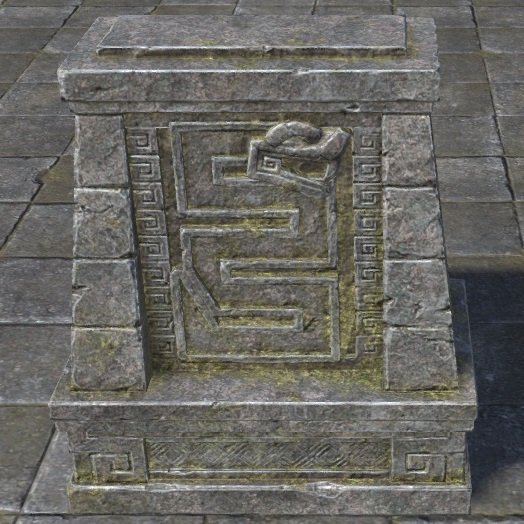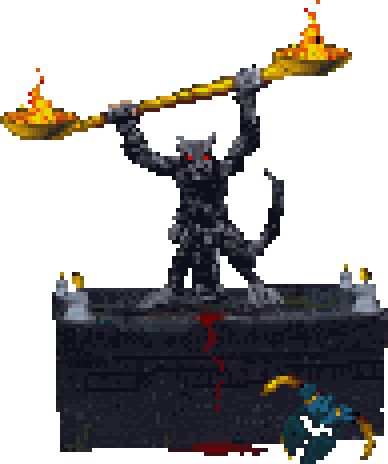User:Jimeee/Sandbox3/5
Other Deities[edit]
The Lady in the Cistern[edit] | |
|
The Lady in the Cistern was the name given to a mysterious statue found hidden away in the sewers under Abah's Landing in Hew's Bane. When the sewers became the headquarters of the Thieves Guild during the mid-Second Era, the statue of the unknown woman with a serpent coiled around her was discovered hidden in a cistern that was once bricked off behind another cistern.[1] It remained unknown to the guild who she represented or why the statue was built there, but guild members had numerous theories. These included Nocturnal,[1] the Lucky Old Lady statue in Bravil,[2] the Night Mother (and the snake wrapped around her representing Sithis)[3] Hazadiyya Sea-Queen (wrapped in a sea serpent)[4] or Zeqqi, the Madonna of Tears.[5] Another theory was it represented the Yokudan goddess Leki administering her Ephemeral Feint, given this was how sculptors would depict it during early First Era, and also that it bore similarities to the enormous statue of Prince Hubalajad south of the Abah's Landing's harbor. It was speculated that the sculptor who hid Leki's modest statue away in the cistern did so to spite Prince Hubalajad and his achievements.[6] |
 ESO ESO
|
Night Mother[edit] | |||
 ESO ESO
|
 ESO ESO
|
 Oblivion Oblivion
|
 Skyrim Skyrim
|
|---|---|---|---|
|
During the mid-Second Era, a seated statue of the Night Mother stood inside the Dark Brotherhood's Gold Coast sanctuary. Five skulls were placed on her lap, representing her five murdered children.[7] |
The motif of her murdered five children is again represented in bas-reliefs found on the Black Doors of Dark Brotherhood sanctuaries in the Gold Coast and Blackwood. Here it shows the Night Mother wielding a blade over the heads of her children, whom she later murdered in a dark ritual with Sithis who is also represented by a large skull.[8][9] During the Third and Fourth Eras, Dark Brotherhood sanctuary doors in Cyrodiil and Skyrim similarly depicted the Night Mother's murders.[10][11][12] | ||
|
The statue in the center of Bravil was known as the Lucky Old Lady, but unbeknownst to the city folk it was actually a shrine to the Night Mother herself. It was here the Listener of the Dark Brotherhood would prays to the Night Mother each night, who would in turn inform the Listener about targets for assassination. Beneath the statue was the secret crypt of the Night Mother, where the bodily remains of her and her five children were interred. During the late-Third Era after the Purification of the Cheydinhal Sanctuary, the Night Mother summoned the Black Hand to her crypt where it was revealed Mathieu Bellamont was a traitor who sought to destroy the Brotherhood.[13] On the 1st of Sun's Dusk in 4E 188, the statue was destroyed after Bravil erupted in violence over a war of control being Cyrodiil's two largest skooma traffickers. Listener Alisanne Dupre attempted to guard the crypt of the Night Mother, but was burned alive and the crypt was raided.[14] |
 Oblivion Oblivion
| ||
Sithis[edit] | ||
 ESO ESO
|
 ESO ESO
|
 Oblivion Oblivion
|
|---|---|---|
|
Argonians are one of the only cultures in Tamriel to openly revere Sithis, and as a result, numerous forms of statuary depicting him can be found across ancient temples in Black Marsh.[15] One notable example was a vast statue of Sithis was built in the temple of Xul-Thuxis in Murkmire, before it was abandoned. The name of the temple translates to "Snake-Means-Death City" - an appropriate name for a temple dedicated to the Dread Father.[16] |
Another large statue could be found as the centerpiece in the ancient Argonian temple of Xith-Izkul, located deep in the heart of Blackwood. The temple later became a sanctuary for the Dark Brotherhood before it purified by the Black Hand and abandoned.[17] |
A skeletal statue of Sithis with a gaping hole in his chest could be found in the ancient ruins of Deepscorn Hollow in Cyrodiil during the late-Third Era. Believed to have been a First Era temple devoted to the Dread Father, its subterranean halls eventually fell into ruin and sank into the boggy southern coast of Blackwood and various dark cults were known to have taken shelter over the years, such as the Unmakers[18][19][20] |
 ESO ESO
|
 ESO ESO
|
 ESO |
|
Ancient Argonians often associated Sithis with serpent or skeletal imagery, and this could be seen in the numerous shrines and idols across Black Marsh.[21][22][23] The likeness of Sithis was also inscribed on brass medallion carried by the Shadowscales as a means to identify fellow members.[24] | ||
Ius[edit] | |
|
Ius the Extremely Agitated is the God of Animals in some folklore. He has statues throughout Valenwood and parts of Hammerfell and Elsweyr. These statues depict Ius as a little misshapen humanoid carrying a rod with scales on each end.[25][26][UOL 1] |
 Arena Arena
|
References[edit]
- ^ a b Lady in the Cistern: Thrag's Theory — Thrag
- ^ Lady in the Cistern: Andarri's Theory — Andarri
- ^ Lady in the Cistern: Velsa's Theory — Velsa
- ^ Lady in the Cistern: Quen's Theory — Quen
- ^ Lady in the Cistern: Walks-Softly's Theory — Walks-Softly
- ^ Lady in the Cistern: Zeira's Theory — Zeira
- ^ Appearance of statue in ESO
- ^ Dark Brotherhood Sanctuary sanctuary in ESO
- ^ Xith-Izkul Sanctuary in ESO
- ^ Dark Brotherhood Sanctuary in Oblivion
- ^ Dark Brotherhood Sanctuary in Skyrim
- ^ Dawnstar Sanctuary in Skyrim
- ^ Honor Thy Mother quest in Oblivion
- ^ Cicero's Journal - Volume 2 — Cicero
- ^ Nisswo Xode's dialogue in ESO
- ^ Xul-Thuxis Loading screen in ESO: Murkmire
- ^ A Ghost from the Past quest in ESO
- ^ Thadarond's dialogue in ESO
- ^ Greywyn Blenwyth's dialogue in ESO
- ^ Deepscorn Hollow loading screen in ESO
- ^ Sithis Shrine Statue contraband item ESO
- ^ Ebony Sithis Idol contraband item ESO
- ^ Murkmire Hearth Shrine, Sithis Coiled furnishing in ESO
- ^ Shadowscale Medallion treasure item ESO
- ^ Ius, Animal God — Buljursoma
- ^ Events of Arena
Note: The following references are considered to be unofficial sources. They are included to round off this article and may not be authoritative or conclusive.